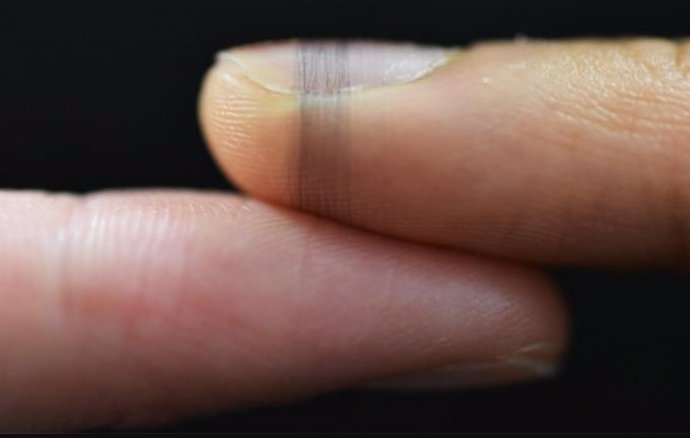“Spider Silk” Bioelectronics – UNIVERSITY OF CAMBRIDGE
May 27. () –
Cambridge scientists have developed a method to make sensors that can be printed directly and imperceptibly on biological surfaces, for example a finger or a flower petal.
The method is inspired by spider silk, which can adapt and adhere to a variety of surfaces. These “spider silks” also incorporate bioelectronicsso that different sensing capabilities can be added to the “network”.
The fibers, at least 50 times smaller than a human hair, are so light that the researchers printed them directly onto the fluffy seed of a dandelion without collapsing its structure. When printed on human skin, the fiber sensors conform to the skin and expose sweat pores, so their presence is not detected by the user. Tests of fibers printed on a human finger suggest they could be used as continuous health monitors.
This low-waste, low-emissions method of augmenting habitable structures could be used in a variety of fields, from healthcare and virtual reality to e-textiles and environmental monitoring. The results are published in the journal Nature Electronics.
Although human skin is remarkably sensitive, augmenting it with electronic sensors could fundamentally change the way we interact with the world around us. For example, sensors printed directly on the skin could be used for continuous health monitoring, to understand skin sensations, or could improve the feeling of “reality” in games or virtual reality applications.
While wearable technologies with integrated sensors, such as smartwatches, are widely available, these devices can be uncomfortable, annoying, and can inhibit intrinsic skin sensations.
“If you want to accurately detect something on a biological surface like skin or a leaf, the interface between the device and the surface is vital,” he said. it’s a statement Professor Yan Yan Shery Huang from Cambridge’s Department of Engineering, who led the research. “We also want bioelectronics that are completely imperceptible to the user, so that they do not interfere in any way with the way the user interacts with the world, and we want them to be sustainable and generate little waste.”
There are several methods for making wearable sensors, but they all have drawbacks. Flexible electronic devices, for example, are typically printed on plastic films that do not allow gas or moisture to pass through, so it would be like wrapping skin in cling film. Other researchers have recently developed flexible electronic devices that are permeable to gases, such as artificial skin, but they still interfere with normal sensation and rely on energy- and waste-intensive manufacturing techniques..
3D printing is another potential route for bioelectronics, as it generates less waste than other production methods, but leads to thicker devices that can interfere with normal behavior. By spinning electronic fibers, devices are obtained that are imperceptible to the user, but that do not have a high degree of sensitivity or sophistication and are difficult to transfer to the object in question.
DIRECT PRINTING
Now, the Cambridge-led team has developed a new way to make high-performance bioelectronics that can be customized for a wide range of biological surfaces, from the tip of a finger to the fluffy seed of a dandelion, by printing them directly on them. surface. His technique is partly inspired by spiders, that create sophisticated and strong network structures adapted to their environment, using a minimum of material.
The researchers spun their bioelectronic “spider silk” from PEDOT:PSS (a biocompatible conductive polymer), hyaluronic acid, and polyethylene oxide. The high-performance fibers were produced from a water-based solution at room temperature, allowing the researchers to control the “spinnability” of the fibers. The researchers then designed an orbital spinning method to allow the fibers to transform into living surfaces, even in microstructures such as fingerprints.
Testing of the bioelectronic fibers, on surfaces such as human fingers and dandelion seeds, showed that they provided high-quality sensor performance while being imperceptible to the host.
“Our spinning approach allows bioelectronic fibers to follow anatomy in different ways, both at micro and macro scales, without the need for image recognition,” said Andy Wang, first author of the paper. “It opens up a completely different angle in terms of how you can make sustainable sensors and electronic devices. It’s a much simpler way to produce large surface area sensors.”
Most high-resolution sensors are manufactured in an industrial clean room and require the use of toxic chemicals in an energy-intensive, multi-step manufacturing process. The sensors developed by Cambridge can be manufactured anywhere and used a small fraction of the energy required by normal sensors.
Bioelectronic fibers, which are repairable, can simply be washed when they have reached the end of their useful life and generate less energy.










![[Img #74662]](https://thelatestnews.world/wp-content/uploads/2024/12/Organisms-with-the-shortest-life-150x150.jpg)



![[Img #74662]](https://thelatestnews.world/wp-content/uploads/2024/12/Organisms-with-the-shortest-life-300x200.jpg)

Add Comment